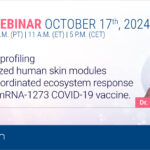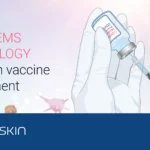An ex vivo human skin model for healing of infected wound
USING HYPOSKIN EX VIVO SKIN MODEL
Research by E. Pagès (Genoskin), M. Pastore (Genoskin), L. Rosselle (TissueAegis), A. Barras (UMR 8520 – IEMN), N. Skandrani (TissueAegis), A.R. Cantelmo (INSERM U1003), R. Boukherroub (UMR 8520 – IEMN), P. Descargues (Genoskin), S. Szunerits (UMR 8520 – IEMN)
Skin possesses excellent regeneration properties that allows its rapid healing upon dermal injury. If wounds fail to heal in an orderly and timely manner, chronic ulcers (e.g. diabetic foot ulcers, venous leg ulcers, pressure ulcers, etc.) develop. Efficient treatment of chronic wounds remains a global challenge. Next to wound debriding or hyperbaric oxygen therapy, a myriad of topical therapies and dressings are available to the clinicians with very few having shown their effectiveness in promoting wound repair. The integration of nanomaterials into wound healing bandages is believed to be one possibility to overcome some of the current limitations. To test the potential of these innovate wound healing dressings, wound infection models are needed. Current research on wound infections is mainly conducted on animal models, which often limits direct transferability to human and poses ethnic issues. Some of these limitations can be overcome by using an ex vivo skin model, HypoSkin®, human skin discarded from cosmetic surgery.
Wound Healing Processes occuring in Hyposkin® Model
HypoSkin® is an ex vivo human skin model with epidermis, dermis, and hypodermis. The skin explant is embedded in a proprietary gel-like matrix with the epidermal surface left in direct contact with the air.
To generate a wound, a defect of a controlled diameter is performed to remove all the epidermis and upper part of the dermis. A silicon ring is adhered on the skin surface to prevent lateral bacteria leakage. The system is mounted into cell culture inserts and maintained in standard cell culture conditions.
At day 0, the edge of the wound was a clear cut of the epidermis. From day 2, an epithelial tongue appeared and migrated until day 7. A crust was also visible at day 7. Cells in the migrating epithelial tongue were proliferating (Ki-67 positive staining) and expressing K17 which is a specific marker of keratinocytes migrating over the wound bed.
Wounded HypoSkin® recapitulates some aspects of wound healing
Wound infection with Staphylococcus aureus
Number of bacteria colony forming units (CFU) in skin infected for 4 days by different concentrations of S. aureus is showed on the graph. No bacteria were detected on uninfected skin (control). The detected amount of bacteria in infected skins was ≈1×10^8 CFU/g of skin.
Skin containing S. Aureus bacteria
Staphylococus Aureus Colonization
Biofilm developement on the wound (A-B)
Hematoxylin and eosin staining shows the structure of the wound (dermis in pink) and bacteria (dark purple). A S. aureus biofilm developed over 4 days of infection in the wound.
S. Aureus specific biofilm (C-D)
S. Aureus was detected on tissue sections by using a specific antibody. High level of green fluorescence indicates the presence of S.aureus within the wound.
Bacterial colonization of skin tissue (E-F)
Scanning electron microscopy analysis shows presence of bacteria among collagen fibers.
Histological Observations of Infected Wounds
Skin Inflammation in Response to Staphylococcus aureus Colonization
The analysis of pro-inflammatory cytokines expression by qPCR on total skin lysates shows an increase of cytokines expression levels after 4 days post-infection with S.aureus, confirming the initiation of inflammatory responses after bacterial infection.
S. Aureus induces inflammatory response








